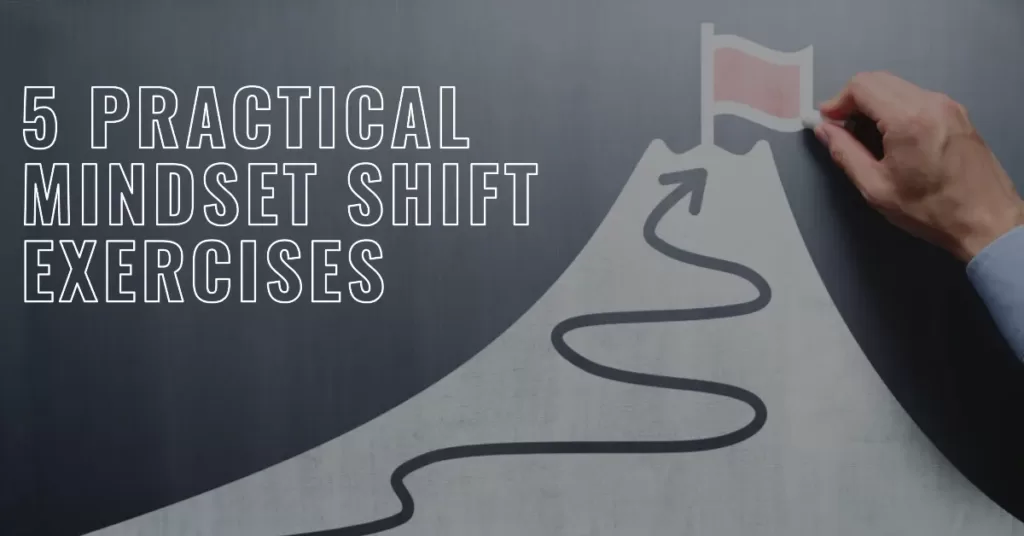Are you a high achiever looking to unlock your full potential? Are you constantly seeking ways to level up your mindset and achieve even greater success? Look no further! In this article, we will explore five practical mindset shift exercises specifically designed for high achievers like yourself. These exercises will empower you to overcome self-limiting beliefs, cultivate a growth mindset, and unleash your true potential. Whether you are an entrepreneur, a professional, or someone simply striving for personal growth, these mindset shift exercises will provide you with the tools and strategies to reach new heights. From reframing negative thoughts to practicing gratitude, each exercise is intended to challenge your current mindset and pave the way for a more fulfilling and successful life. Get ready to step out of your comfort zone and embark on a transformative journey toward becoming the best version of yourself. Let’s dive in and discover the power of mindset shifts for high achievers!
Table of Contents
- 1 The Importance of Mindset for High Achievers
- 2 Common Mindset Challenges for High Achievers
- 3 Exercise 1: Mastering Self-Talk by Using Affirmations
- 4 Exercise 2: Visualization and Imagery Training
- 5 Exercise 3: Effective Goal Setting
- 6 Exercise 4: Mindful Journaling and Self-Reflection
- 7 Exercise 5: Admitting to Mistakes
- 8 Implementing Mindset Shift Strategies in Daily Life
- 9 Tracking Progress and Staying Motivated
- 10 Conclusion: Mindset is Crucial for High Achievers
The Importance of Mindset for High Achievers
As a high achiever, your mindset plays a crucial role in determining your success. Your mindset is the lens through which you perceive the world, and it influences your thoughts, emotions, and actions. Having a positive and growth-oriented mindset can propel you toward your goals, while a negative and fixed mindset can hold you back.
High achievers often face unique challenges, such as the fear of failure, perfectionism, and self-doubt. These challenges can create mental barriers that hinder progress and prevent you from reaching your full potential. By actively working on your mindset, you can break free from these limitations and create a solid foundation for success.
Common Mindset Challenges for High Achievers
Before diving into the practical exercises, let’s explore some common mindset challenges that high achievers often face. By identifying and understanding these challenges, you can better tailor your mindset shift strategies to address them effectively.
One common challenge is the fear of failure. High achievers are often driven by a desire to succeed, and the fear of failure can be paralyzing. This fear can lead to self-doubt, procrastination, and a reluctance to take risks. Overcoming the fear of failure is essential for embracing new opportunities and striving for growth.
Another challenge is perfectionism. High achievers tend to set high standards for themselves and may feel the need to excel in every aspect of their lives. While having high standards can be beneficial, perfectionism can become a hindrance. It can lead to excessive self-criticism, burnout, and a fear of making mistakes. Finding a balance between striving for excellence and embracing imperfection is crucial for maintaining a healthy mindset.
Self-doubt is yet another challenge that high achievers often grapple with. Despite their achievements, they may doubt their abilities and question their worthiness of success. This self-doubt can erode confidence and limit potential. Overcoming self-doubt requires cultivating self-compassion, building self-confidence, and reframing negative self-talk.
Now that we have identified some common mindset challenges, let’s explore the practical exercises that can help you overcome them and shift toward a more empowering mindset.
Exercise 1: Mastering Self-Talk by Using Affirmations

Self-talk refers to the inner dialogue that takes place within your mind. It can either be positive and uplifting or negative and self-sabotaging. By mastering your self-talk, you can change your perception of yourself and the world around you.
One powerful technique to master self-talk is by using affirmations. Affirmations are positive statements that you repeat to yourself to reinforce empowering beliefs. They can help you challenge and reframe negative thoughts, boost your self-confidence, and cultivate a positive mindset.
To start using affirmations, identify the self-limiting beliefs or negative thoughts that are holding you back. Then, create positive affirmations that directly counter these beliefs. For example, if you often find yourself thinking, “I’m not good enough”, you can replace it with an affirmation like, “I am capable and deserving of success”.
Once you have identified your affirmations, repeat them daily, preferably in front of a mirror. Say them with conviction and believe in their truth. Over time, these affirmations will become ingrained in your subconscious mind, leading to a profound shift in your mindset.
Exercise 2: Visualization and Imagery Training
Visualization is a powerful technique that involves creating vivid mental images of your desired outcomes. By visualizing your goals and aspirations, you can program your mind for success and increase your motivation and focus.
To practice visualization, find a quiet and comfortable space where you won’t be disturbed. Close your eyes and imagine yourself achieving your goals. Visualize every detail, from the sights and sounds to the emotions you would experience. Engage all your senses to make the visualization as real as possible.
As you continue to visualize, pay attention to the positive emotions that arise within you. Allow yourself to truly feel the joy, satisfaction, and fulfillment of achieving your goals. This emotional connection will strengthen your motivation and reinforce your belief in your ability to achieve your goals.
Visualization can be enhanced by combining it with other forms of imagery training. This may involve creating a vision board or a digital collage of images that represent your goals and aspirations. Place this vision board somewhere visible, such as your workspace or bedroom, and spend a few minutes each day focusing on it. This visual reminder will keep your goals at the forefront of your mind and inspire you to take action.
Exercise 3: Effective Goal Setting
Goal setting is a fundamental practice for high achievers, but it’s essential to approach it with the right mindset. Effective goal setting involves setting specific, measurable, attainable, relevant, and time-bound (SMART) goals.
Start by clarifying your long-term vision and identify the specific objectives that will lead you there. Break these objectives down into smaller, manageable goals that you can work on daily, weekly, or monthly. Each goal should be aligned with your values and aspirations, and it should stretch your abilities without overwhelming you.
To stay motivated and committed to your goals, it’s crucial to track your progress. Keep a journal or use a goal-tracking app to record your achievements, setbacks, and lessons learned. Celebrate your wins, no matter how small, and learn from any obstacles you encounter along the way.
Remember, effective goal setting is not just about the destination; it’s about the journey. Embrace the process, and enjoy the growth and personal development that comes with pursuing your goals.
Exercise 4: Mindful Journaling and Self-Reflection
Mindful journaling and self-reflection are powerful tools for self-awareness and personal growth. By taking the time to reflect on your thoughts, emotions, and experiences, you can gain valuable insights into your mindset and make conscious changes.
Set aside dedicated time each day or week for mindful journaling. Find a quiet and comfortable space where you can reflect without distractions. Start by writing down your thoughts and feelings, allowing yourself to express them freely and without judgment.
As you journal, ask yourself thought-provoking questions that encourage self-reflection. For example, “What limiting beliefs am I holding onto?”, “What can I learn from this setback?”, or “What strengths and qualities do I possess that can help me overcome challenges?” These questions will help you gain clarity, identify patterns, and uncover areas for growth.
Additionally, practicing gratitude in your journaling can shift your mindset toward positivity and abundance. Take a moment to write down three things you are grateful for each day. This simple practice can cultivate a sense of appreciation and contentment, even in challenging times.
Exercise 5: Admitting to Mistakes

High achievers often have a fear of making mistakes and view them as failures. However, embracing mistakes as opportunities for growth is a vital mindset shift for success.
Admitting to mistakes requires humility and self-awareness. It involves acknowledging when you’ve made a wrong decision or taken a misstep, and taking responsibility for the consequences. By doing so, you can learn from your mistakes, make necessary adjustments, and grow stronger.
To cultivate a mindset that embraces mistakes, start by reframing your perception of failure. Understand that failure is not the end but a stepping stone toward success. Recognize that mistakes are valuable learning experiences that can lead to innovation, resilience, and personal growth.
When you make a mistake, take the time to reflect on what went wrong and why. Be honest with yourself and identify the lessons you can learn from the experience. Use these insights to make improvements and avoid repeating the same mistakes in the future.
Remember, admitting to mistakes is not a sign of weakness; it’s a sign of strength and a willingness to grow.
Implementing Mindset Shift Strategies in Daily Life
Now that you have learned about these practical mindset shift exercises, it’s time to implement them in your daily life.
Here are some tips to help you integrate these strategies seamlessly:
- Consistency is key: Practice these exercises regularly to experience lasting mindset shifts. Set a specific time each day or week to work on your mindset and make it a non-negotiable part of your routine.
- Accountability: Find an accountability partner or join a mastermind group to stay motivated and committed to your mindset shift journey. Share your goals and progress with someone who can provide support and hold you accountable.
- Patience and perseverance: Changing your mindset takes time and effort. Be patient with yourself and embrace the process. Celebrate small wins along the way and stay committed to your growth.
- Seek professional guidance: If you find it challenging to navigate your mindset shift journey alone, consider working with a coach or therapist who specializes in mindset and personal development. They can provide guidance, support, and valuable insights tailored to your specific needs.
Tracking Progress and Staying Motivated
To track your progress and stay motivated, consider using a mindset journal or creating a digital tracker. Record your experiences, insights, and mindset shifts as you work through the exercises. Reflect on your growth and celebrate milestones along the way.
Additionally, surround yourself with supportive and like-minded individuals who share your drive for personal growth. Engage in communities, attend workshops, or join online forums where you can connect with others on a similar journey. Sharing your experiences, challenges, and successes with others can provide inspiration, motivation, and a sense of belonging.
Remember, mindset shifts are an ongoing process. As you continue to implement these exercises and strategies, you will notice gradual changes in your mindset, behavior, and ultimately, your results.
Conclusion: Mindset is Crucial for High Achievers

Mindset is a powerful tool that can unlock your full potential as a high achiever. By actively working on your mindset and integrating these practical exercises into your daily life, you can overcome self-limiting beliefs, cultivate a growth mindset, and unleash your true potential.
From mastering self-talk to visualization and imagery training, effective goal setting, mindful journaling, and embracing mistakes, each exercise is designed to challenge your current mindset and pave the way for a more fulfilling and successful life.
Remember, mindset shifts require consistent effort, patience, and self-reflection. Embrace the journey, and celebrate every step forward. You have the power to transform your mindset and become the best version of yourself. Now, go out there and make it happen!







